Related Research Articles

Kotonishiki Katsuhiro is a former sumo wrestler from Takasaki, Gunma Prefecture, Japan. He began his career in 1984, reaching the top makuuchi division in 1989. He won two top division tournament titles from the maegashira ranks, the first in 1991 and the second in 1998. His highest rank was sekiwake, which he held 21 times. He earned eighteen special prizes during his career, second on the all-time list, and defeated yokozuna eight times when ranked as a maegashira. He retired in 2000 and after a long stint as a sumo coach at Oguruma stable, took the vacant elder name Asahiyama and branched out to form his own stable of the same name.

Miyabiyama Tetsushi is a former sumo wrestler from Mito, Ibaraki, Japan. A former amateur champion, he turned professional in 1998. With the exception of two tournaments, he was ranked in the top division of professional sumo from 1999 until the end of his career in 2013, holding the second highest rank of ōzeki from 2000 to 2001. He won eight special prizes and was runner-up in four top division tournaments. He wrestled for Fujishima stable, where he worked as a coach until opening his own Futagoyama stable.

Dejima Takeharu is a former sumo wrestler from Kanazawa, Ishikawa, Japan. A former amateur champion, he made his professional debut in 1996, reaching the top makuuchi division the following year. In July 1999 he won the yūshō or tournament championship and earned promotion to the second highest rank of ōzeki. He lost the rank in 2001 and, for the most part, remained a maegashira until his retirement in 2009. He won ten special prizes and six gold stars over his long career. He wrestled for Musashigawa stable. He is now an elder of the Japan Sumo Association under the name Ōnaruto Oyakata.

Wakanosato Shinobu is a retired sumo wrestler from Hirosaki, Aomori, Japan. He made his debut in the top division in 1998, and his highest rank was sekiwake. He holds the record for the most consecutive tournaments ranked in the junior san'yaku ranks of sekiwake and komusubi. He won ten special prizes and was twice runner-up in a tournament. He earned two gold stars for defeating yokozuna at a maegashira rank. He had 1691 career bouts, sixth on the all-time list. He retired in 2015 and was a coach at Tagonoura stable, until opening his own Nishiiwa stable in February 2018.

Takekaze Akira is a former professional sumo wrestler from Akita Prefecture, Japan. A former amateur sumo champion, he turned professional in 2002, reaching the top makuuchi division the following year. He was a runner-up in one tournament, earned two special prizes for Fighting Spirit, and one gold star for defeating a yokozuna. Takekaze is in first place for the slowest promotion from makuuchi debut to the third highest sekiwake rank in history. Aged 35 years and two months, he is in first place for the eldest to make his sekiwake debut post World War II. He was a member of Oguruma stable. He retired in January 2019 to become an elder of the Japan Sumo Association under the name Oshiogawa-oyakata.

Tochisakae Atsushi is a former sumo wrestler from Saga Prefecture, Japan. He made his professional debut in 1993, reaching the top division for the first time in 2000. His highest rank was maegashira 1. He suffered many illness and injury problems throughout his career. He retired in 2008 and is now an elder of the Japan Sumo Association under the name of Mihogaseki, working as a coach at Kasugano stable.
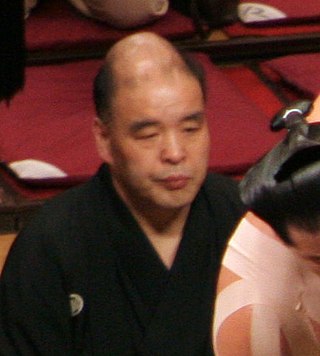
Daiju Hisateru is a former sumo wrestler from Hokkaidō, Japan. His highest rank was ōzeki, but he held the rank for only five tournaments, fewer than any ōzeki in the modern era. He won eleven sanshō or special prizes during his top division career which lasted from 1970 to 1977. He was the head coach of Asahiyama stable from 1997 until 2015.

Asanowaka Takehiko is a former sumo wrestler from Ichinomiya, Aichi Prefecture, Japan. His highest rank was maegashira 1. He is now a sumo coach.
Kotogaume Tsuyoshi is a former sumo wrestler from Yatsuo, Nei District, Toyama Prefecture, Japan. He joined sumo in 1979 and made the top makuuchi division in 1985. His highest rank was sekiwake, which he held on twelve occasions. After his retirement in 1997 he worked as a coach at Sadogatake stable until 2007.
Misugisato Kōji is a former sumo wrestler from Shiga Prefecture, Japan. He made his professional debut in 1979, and his highest rank was komusubi which he reached in 1989. He earned six gold stars for defeating yokozuna and one special prize for Fighting Spirit. He retired in 1998 and became an elder of the Japan Sumo Association before leaving the sumo world in 2006.

Takamisugi Takakatsu is a former sumo wrestler from Kawasaki, Kanagawa, Japan. His highest rank was komusubi. He is now the head coach of Tokiwayama stable, renamed from Chiganoura stable.
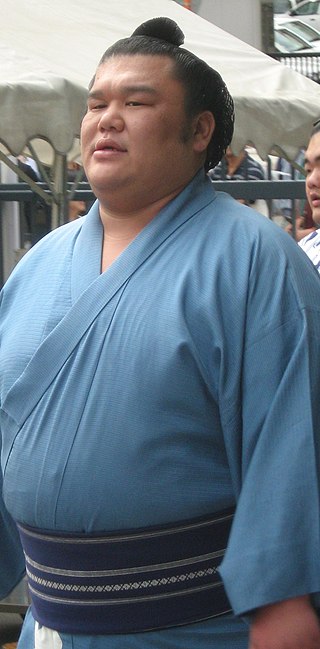
Kimurayama Mamoru is a former professional sumo wrestler from Wakayama Prefecture, Japan. His highest rank was maegashira 7. He is now a coach at Kasugano stable. He was the only wrestler in the elite ranks in his time from Wakayama Prefecture.
Hamanoshima Keishi is a former sumo wrestler from Uto, Kumamoto Prefecture, Japan. A former amateur champion, he turned professional in 1992, reaching the top makuuchi division in 1994. His highest rank was komusubi. After his retirement from active competition in 2004 he became an elder of the Japan Sumo Association and founded Onoe stable in 2006, which has produced a number of top division wrestlers.
Tochitsukasa Tetsuo is a former sumo wrestler from Nakagawa, Nagoya, Aichi Prefecture, Japan. His highest rank was sekiwake. After his retirement from sumo in 1992 he became an elder of the Japan Sumo Association and established Irumagawa stable in 1993, which he ran until 2023.
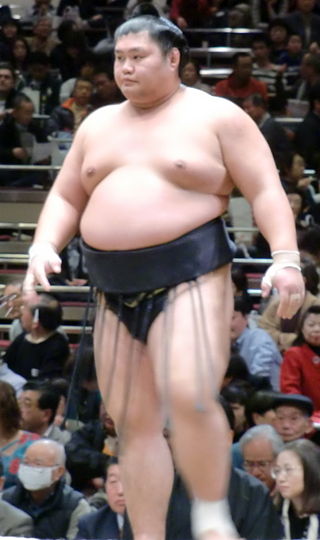
Wakakōyū Masaya is a former professional sumo wrestler from Funabashi, Japan. His highest rank was komusubi. The last two characters of his ring name were taken from his mentor and coach at Ōnomatsu, the former Masurao. He was only the second wrestler from his stable to reach the top division. He was runner-up in one tournament and earned one special prize, for Fighting Spirit. He is now a sumo coach.
Naminohana Kazutaka is a former sumo wrestler from Namioka, Aomori, Japan. He was active from 1984 until 1997 and his highest rank was komusubi. He fought for Futagoyama stable and won one special prize for Fighting Spirit. After retiring at age 28 because of injury he went into the restaurant business.
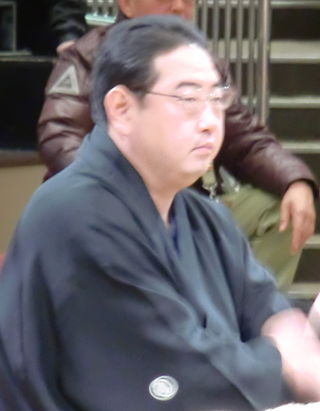
Oginohana Akikazu is a former sumo wrestler from Ichikawa, Chiba, Japan. He made his professional debut in July 1983, and reached the top division in January 1990. His highest rank was maegashira 2. He retired in July 1998. He is the son of former sekiwake Oginohana Masaaki and the elder brother of former komusubi Oginishiki. Since 2014 he has been the head of the Dewanoumi stable.
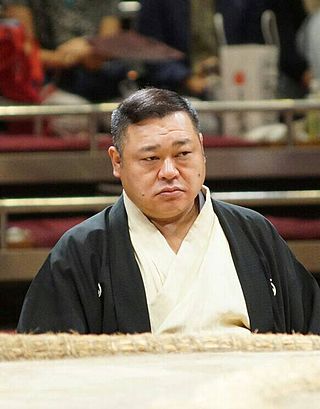
Aogiyama Hideki is a former sumo wrestler from Hikone, Shiga, Japan. He made his professional debut in March 1985, and reached the top division in March 1993. His highest rank was maegashira 1. He retired in November 2003, and he is an elder in the Japan Sumo Association under the name Edagawa.

Ōikari Tsuyoshi is a former sumo wrestler from Kyoto, Japan. He made his professional debut in March 1995, and reached the top division in November 1998. His highest rank was maegashira 11. He retired in November 2004, and as of 2016 he is an elder in the Japan Sumo Association under the name Kabutoyama.

Wakasegawa Yoshimitsu was a sumo wrestler from Sakata, Yamagata, Japan. He made his professional debut in 1978, reaching the top makuuchi division for the first time in 1983. His highest rank was maegashira 1. He retired in 1992 and worked in the restaurant business after leaving sumo.
References
- ↑ "Enazakura Tooru Kabu History". Sumo Reference. Retrieved 8 September 2012.
- ↑ Sharnoff, Lora (1993). Grand Sumo. Weatherhill. p. 147.
- 1 2 3 Patmore, Angela (1990). The Giants of Sumo. MacDonald & Co. p. 99. ISBN 0356181200.
- ↑ "Enazakura Tooru Rikishi Information". Sumo Reference. Retrieved 8 September 2012.